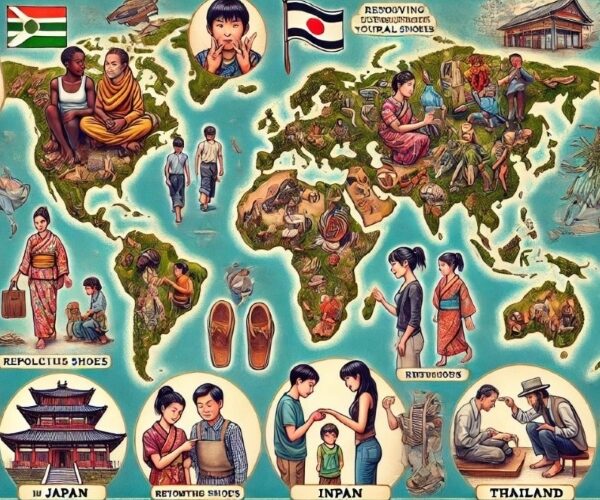Taboos Unveiled: A Traveller’s Guide to Cultural Sensitivity and how to avoid Problems
September 3, 2024

As vast as the world is, every corner of it is decorated with unique traditions, customs, and taboos. it becomes our responsibility to navigate these cultural practices with utmost respect and sensitivity, adhering to the saying, ‘‘When in Rome, do as the Romans do.’’ This old adage reminds us to assimilate ourselves into the local culture without compromising the values held dear by our hosts. One such aspect that demands a traveller’s attention is the display of taboos prevailing across different regions. While these may seem like small details, they hold great significance in preserving the cultural fabric of a society. Now, let us delve into a few instances where understanding and respecting local taboos are paramount.
Africa
In the heart of Africa, particularly in places like rural Malawi and Zambia, a unique taboo comes to light. Here, the public display of affection, such as couples kissing, is considered a cultural no-no. In their culture, love is deeply cherished, but the expression of that love is a private affair between two people. Witnessing couples engage in public displays of affection or kissing can attract unnecessary attention and may be perceived as a breach of social norms. So, the next time you are in some parts of Africa, let’s say Malawi or Zambia, understand that kissing and public displays of affection should be kept between you and your lover—perhaps when everyone is asleep or within the confines of your four-cornered room. This is essential if you wish to avoid attracting unnecessary attention or disrespecting the host culture.
Asia
Moving eastward to Asia, specifically in countries like Japan, there exists a customary taboo related to footwear. In Japanese households and many public spaces, it is customary to remove one’s shoes before entering. You might wonder, do I need to go barefoot? Yes! You need to remove your shoes. Expanding on this fascinating aspect of Japanese culture, the tradition of removing shoes extends beyond mere practicality. It’s a ritual deeply embedded in the ethos of cleanliness and respect. In Japanese homes, the removal of shoes signifies a symbolic transition from the outer world to the inner holy place, creating a harmonious and sacred space.This cultural practice isn’t limited to private residences; it gracefully extends to various public spaces, such as traditional ryokans, temples, and even some restaurants. Each instance becomes an opportunity to connect with the cultural heartbeat of Japan. The act of removing shoes isn’t viewed as a clumsy task but as a gesture of mindfulness, acknowledging the shared responsibility for maintaining a clean and harmonious environment. Moreover, this ritual is a testament to Japan’s collective consciousness of unity and consideration for others. It’s not just about personal cleanliness; it’s a communal effort to preserve the purity of shared spaces. Visitors who embrace this tradition find themselves not only participating in a cultural norm but also gaining a deeper understanding of the Japanese way of life.
So, as you embark on your journey to Japan, consider the act of removing your shoes not as a mere requirement but as an invitation to immerse yourself in a tradition that goes beyond the practical, offering a glimpse into the cultural practice that make Japan truly unique. And rest assured, your shoes will likely be waiting faithfully for your return.
Should we go to South East Asia? Let us explore a region known for its rich cultural heritage. The concept of pointing with one’s feet in places like Thailand and other South-east Asian countries is considered highly disrespectful. Feet are seen as the lowest part of the body, and using them to point at people or religious objects is seen as offensive. If you have plans to travel to Thailand and other South-east Asian countries, remember that feet are for walking, not for pointing at anyone, and that includes religious objects. It’s quite strange how some people raise their legs to use their feet for pointing at something.
Continuing our global journey but let us stay in Asia and dig into the rich and diverse cultures of India and Indonesia, specifically exploring the rules surrounding the use of the left hand in these countries. In these vibrant societies, it is deemed impolite to eat or pass objects with the left hand. The cultural significance attached to this practice is rooted in traditional beliefs and personal hygiene norms. The left hand has long been associated with personal hygiene practices in these regions. Therefore, using the left hand for communal activities, such as sharing food or passing objects, can be perceived as disrespectful. It’s not merely a matter of practicality but holds a deeper cultural meaning. So, if you find yourself in India or Indonesia, remember to embrace the local customs and traditions by using your right hand for these communal interactions, showcasing your respect for their cultural practices.
Let us go to the Middle East, In Saudi Arabia, it’s crucial to understand that a high value is placed on modesty, especially in dressing. As travellers, particularly women, it is essential to dress conservatively to honour and adhere to local customs. Opting for clothing that is loose-fitting and concealing is not only a matter of courtesy but a fundamental sign of respect. Attire that is tight-fitting or reveals body contours is not only considered offensive but is also deemed the utmost disrespect towards the cultural norms of Saudi Arabia. Expanding on this, it’s important to note that Saudi Arabian society places a significant emphasis on modest dress, reflecting the broader cultural and religious values. Women are encouraged to cover their bodies modestly, including their hair, and to avoid clothes that may draw undue attention. Traditional, loose-fitting garments such as abayas for women are commonly worn as a gesture of cultural acceptance and respect. As a traveller, adopting this conservative approach not only aligns with local expectations but also facilitates a more positive and harmonious experience within the community. It’s a way of acknowledging and appreciating the cultural norms that makes Saudi Arabia unique. Furthermore, recognizing the cultural significance of modest dressing goes beyond mere adherence to rules; it is a means of cultural exchange and mutual understanding. By respecting and embracing these customs, travellers contribute to building bridges of understanding and appreciation, fostering a sense of unity in diversity.
So, if you have plans to explore the enchanting landscapes and rich heritage of Saudi Arabia, consider your attire as more than just clothing – it becomes a symbol of your respect for the local traditions and an expression of your willingness to engage in a meaningful cultural dialogue.
Europe
As our journey continues into Europe and the Mediterranean, particularly in Greece, it becomes crucial to recognize the cultural significance attached to the head gesture. While a casual nod is often interpreted as a universal sign of agreement in many cultures, it takes on a different meaning in Greece. In this context, a single nod upward is commonly used to signal disagreement or disbelief. Therefore, it becomes essential for travellers to accurately interpret non-verbal cues to navigate social interactions effectively.
North- and South America
As we explore diverse cultural norms around the world, let’s not overlook the customs of the indigenous peoples of America. Within many Native American communities, there exists a unique perspective on eye contact during conversations. Staring directly into someone’s eyes is considered intrusive and disrespectful. Instead, adopting a softer gaze or focusing on other facial features is deemed a more culturally appropriate approach. This cultural nuance emphasizes the importance of respecting varying customs and adapting our behaviour to create meaningful and respectful cross-cultural connections.
If you are planning to cruise in South America, specifically Brazil, personal space and touch should be aspects you need to consider. While Brazilians are generally warm and affectionate, there is a cultural emphasis on respecting personal space, especially when interacting with strangers or new acquaintances. Physical contact, such as hugging and kissing on the cheek, is common among friends and family. However, it is crucial to critically analyse the environment and the comfort level, especially in more public settings. During celebratory events like Carnival, people might be more open to physical contact than in business or formal settings. A more reserved approach is advisable in these situations. In addition, it’s important to understand that Brazilians are adept at non-verbal communication, and recognizing these cues is essential. If someone takes a step back or avoids physical contact, it is an indication of their preference for more personal space. Being aware of personal space norms in Brazil contributes to a more culturally sensitive and enjoyable travel experience. Incorporating these cultural insights into your interactions enhances your ability to connect with locals and fosters a deeper appreciation for the diverse and dynamic Brazilian culture.
These examples just touch the surface of the various taboos around the world. The important lesson for every traveller is to be aware of cultural differences. Whether it’s avoiding public displays of affection in Malawi and Zambia, taking off shoes before entering a Japanese home, or using the right hand in South-east Asia, knowing and respecting these cultural details makes our travels more enjoyable. In a world that invites exploration, let our journeys be defined not only by the places we visit but by the meaningful connections we create. By accepting the customs and taboos of the places we explore, we help preserve their cultural heritage and promote mutual respect that goes beyond borders. As we embrace the role of global citizens, let’s be mindful, leaving behind only footprints of understanding and goodwill as we travel.







